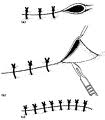A common term that is used in plastic surgery, and one that patients know little about, is a dog-ear. It is an uncomplimentary and perhaps misleading name for a common plastic surgery deformity. Patients may become aware of it when they learn they have it and may need to do something about it for the best cosmetic result.
This skin deformity denotes the bunching of skin at the end of an incision after wound closure. It is the result of an excess of skin that bunches up like a standing cone at the tail of the wound. Technically, it occurs when separated wound edges are closed that are separated at an angle. It can appear everted and protruding from the skin edges or it can be inverted and depressed below the skin surface. I don’t know how it got the name of dog-ear but it has even been called a pig-ear. Depending upon how you it presents (raised and above the skin or inverted below the skin), I guess it appears as the front or back of dog or pig’s ear. Interestingly, this is the only known plastic surgery skin deformity that is actually named after an animal.
Dog-ears commonly occur at the tail ends of a long wound closure after an ellipitical excision of tissue. In body contouring where large amounts of tissue are excised, they are not rare. Frequently, they occur after abdominoplasties, breast lift and reductions, and any other large elliptical skin removals. We look carefully for them at the time of surgery since we know they do occur. When seen, they are excised and closed so that incision lays flat. This often will extend the length of the incision somewhat.

Dog ears can only be improved by their excision. By removing the extra skin and some underlying fat, the tail of the incision will lay flat. It is important to remember that a dog-ear is often more than just skin. So during its excision, a generous amount of surrounding fat may need to removed as well. This is particularly true at the ends of tummy tuck incisions.
Dog-ears are a frequent, but minor, cosmetic incision deformity that may require scar revision. While it can be unsettling for patients to discover a dog-ear after surgery, they can happen in the best planned and closed wound. They can be easily solved as an office procedure under local anesthesias in most cases with no need to limit most activities afterwards.
Dr. Barry Eppley
Indianapolis, Indiana


